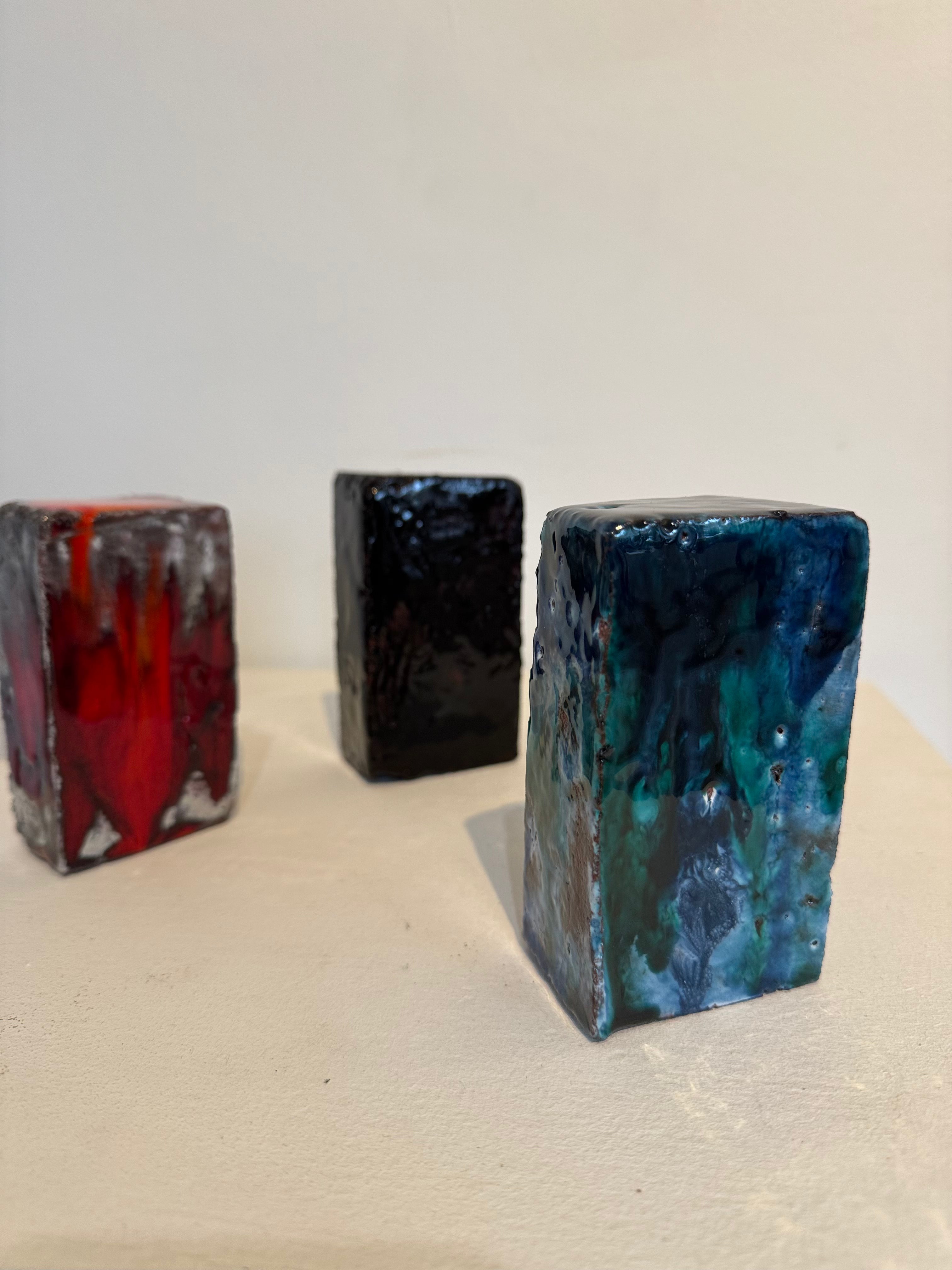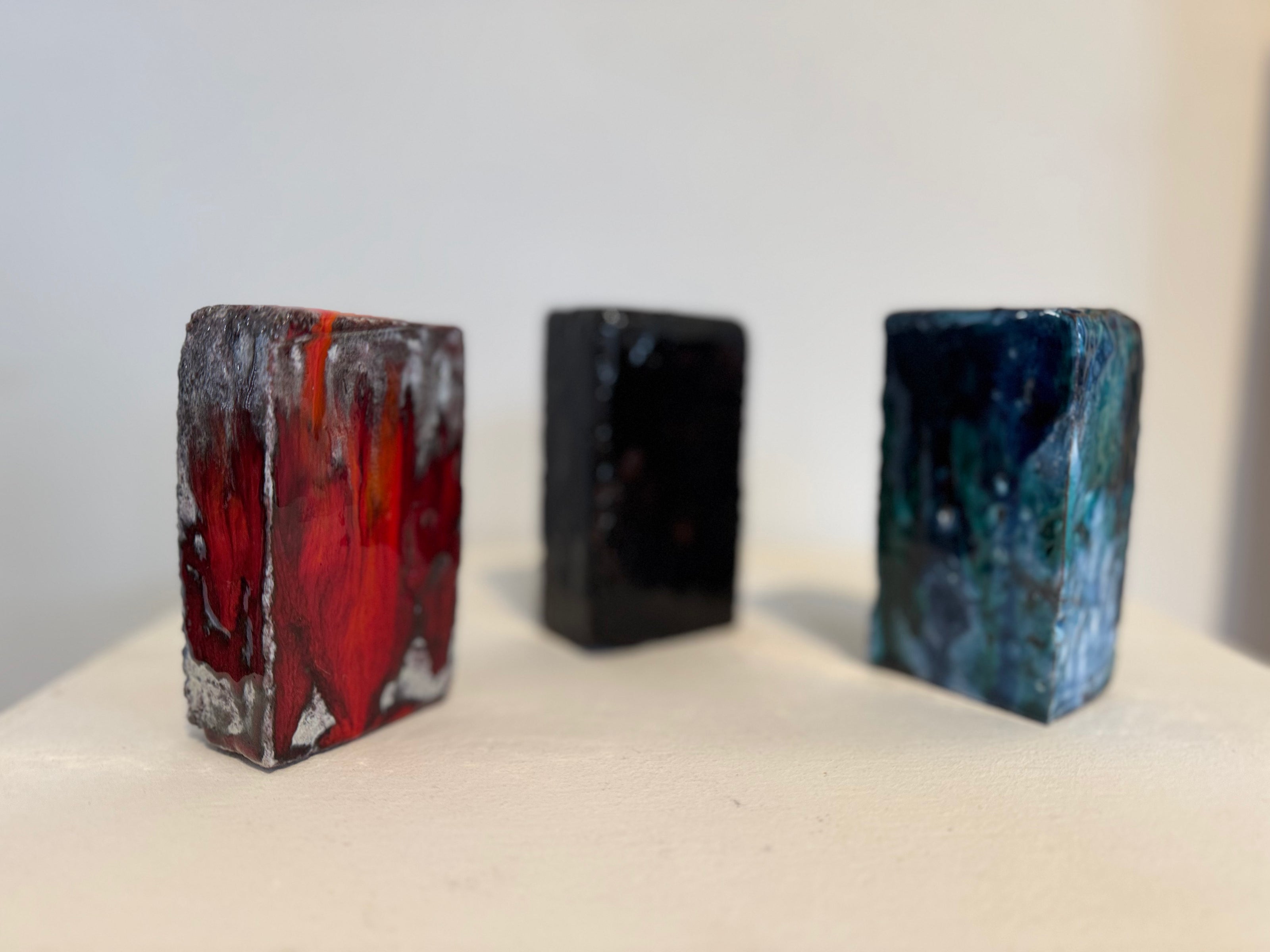1
/
of
3
Sculpture
"Brick by Brick: A Dialogue of Form and Memory".
In the realm of contemporary art, where materials speak as loudly as forms, Anton Kaestner’s sculpture project finds its foundation in the artist’s attachment to Normandy’s architectural history, and a collaboration between two established local institutions— La Poterie du Bavent and La Briquetterie Lagrive.
This endeavor transcends the mundane nature of construction materials to reimagine the brick, a key element in Normandy’s construction history, as a canvas for abstract expression and personal intimacy. The guiding philosophy of this project draws upon the conceptual underpinnings of Anton Kaestner’s work, a figure whose singular yet decisive manipulations of form and material challenge our perceptions of everyday objects. In this case, the brick becomes a symbol not only of structure and function but of intimate inquiry.
At the heart of this project lies a singular ambition: to create 27 unique abstract art pieces, each one composed of a brick as its primary medium. These bricks, however, are far from ordinary. Each piece will emerge, in collaboration with the artist, through the meticulous craftsmanship of La Poterie du Bavent and La Briquetterie Lagrive, two entities whose deep knowledge of their materials introduces layers of complexity to the work.
Anton Kaestner’s Philosophy: A Conceptual Framework
To fully grasp the essence of this project, one must engage with the philosophical backdrop provided by Anton Kaestner’s recent work. Kaestner is an artist whose practice interrogates the relationships between materials, space, and human perception. His art often revolves around taking everyday materials -currently industrial plexiglass plates- and presenting them in ways that disrupt their normal context. His approach to abstraction is less about distorting forms and more about revealing the inherent complexity of the world hidden even within the simplest materials.
In this project, the brick becomes the primary site of inquiry. Like Kaestner’s use of other simple materials, the brick here is reframed—not merely as a building block but as a bearer of meaning. Each of the 27 bricks is treated as an individual art piece, yet they all contribute to a broader dialogue about repetition, transformation, and the recontextualization of everyday materials. Kaestner’s influence guides the creative process, encouraging to see beyond the physicality of the brick and explore its potential as a vessel for abstract thought.
The Collaboration: A Fusion of Tradition and Modernity
For this project, Anton Kaestner solicited two complementary partners :
1892 - La Briquetterie Lagrive (https://www.briqueterielagrive.com), a well-respected producer of high-quality bricks for four generations, provides the raw material for this artistic inquiry. Their bricks, though industrial by nature, possess an inherent elegance, a silent testament to the craftsmanship embedded within their seemingly utilitarian forms. Lagrive’s contribution ensures that the foundation of these abstract works is rooted in strength and durability, creating a harmonious balance between fragility and endurance. The juxtaposition of raw, unglazed bricks with the lustrous, enamel-coated pieces offers a tactile exploration of contrasts: hard and soft, smooth and rough, mundane and extraordinary. Lagrive’s standard bricks are cut to the artist’s specific dimensions.
1842 - La Poterie du Mesnil de Bavent (https://www.poterie-bavent.com), known for its exquisite enamel work (in 2007, the efforts of the company were validated by the award of the “Living Heritage Company” label : «Entreprise du Patrimoine Vivant»), contributes a layer of refinement that stretches back through two centuries of artisanal pottery. Their enamel bricks are a study in the delicate balance of craft and innovation. Here, glaze becomes more than a decorative surface; it is a participant in the dialogue between form and abstraction. Following the artist’s prescriptions, the rich hues and textures provided by the enamel lend each brick a distinct personality, hinting at the untold stories beneath their surfaces.
Both companies have expertise that has spanned centuries.
The Aesthetic Experience: Embracing Abstraction
The visual language of this project is rooted in abstraction, though it avoids the pitfalls of overt complexity. Each brick is a self-contained world, yet it is clear that they form part of a cohesive whole. Each sculpture is born from the intention of the artist, the craftsmanship of his partners and, very much like the painting work on plexiglass, the “chance” linked to the creative process both in terms of the enamel and its reaction in the secrecy of the oven during firing at 1000°C.
The use of enamel by La Poterie du Mesnil de Bavent introduces color as a key player in this dialogue. Rich blues, deep reds, and earth-toned greens offer a spectrum of emotional and intellectual engagement, evoking memories of architecture, of cities built and abandoned, of walls that divide and protect, in a discret evocation of the local Normandy patrimony.
The bricks themselves—in their geometrical/mathematical form, whether glazed or raw—are imbued with a sculptural quality, very much like the monolith of “2001 : a space odyssey”.
Like the plexiglass, the enamel of each individual sculpture reflects and refracts, creating moments of luminosity that contrast with the earthy solidity of the unglazed bricks. This tension between lightness and weight, between gloss and grit, between the impersonal and the intimate, serves as a metaphor for the human condition—grounded in material reality, yet always seeking something beyond.
What makes this project particularly compelling is its humility. While the materials themselves are simple—bricks, enamel, and clay—the resulting works invite profound contemplation and intimate interaction. The act of taking a brick, a universally recognizable object, especially in Normandy, and transforming it into an abstract art piece speaks to the very essence of creativity: the ability to see beyond the surface, find beauty and meaning in the ordinary and transform reality. There is a quiet reverence in the way these materials are handled, a recognition that even the most mundane of objects can become a site for artistic exploration.
The size of the bricks makes them graspable by hand, transforming each of them into a transactional, romantic and personal object, far from their initial anonymity.
The Significance of 27: A Deliberate Choice
The decision to create precisely 27 bricks is not arbitrary. The number carries symbolic weight, representing a journey of completeness without finality. In numerology, 27 is seen as a number of spiritual growth, introspection, and discovery—an apt metaphor for the project’s artistic trajectory. Each brick, then, becomes a marker on this path, a point of reflection that contributes to the broader narrative of the work.
The repetition inherent in creating 27 individual pieces allows for subtle variations to emerge. No two bricks are the same, yet there is an underlying unity that ties them together. This mirrors Kaestner’s exploration of seriality and variation, where repetition serves not as a monotonous act, but as a means of deepening understanding. In this sense, the project becomes a meditation on process—on the slow, deliberate act of creation, on the careful consideration of material and form.
Conclusion: A Dialogue Between Tradition and Innovation
Ultimately, this sculpture project stands as a testament to the power of collaboration. The interplay between La Poterie du Mesnil de Bavent’s artisanal enamel work, La Briquetterie Lagrive’s expertise in brickmaking and the artist creates a fusion of tradition and modernity, of craft and concept.
Through the lens of Anton Kaestner’s philosophy, the project challenges us to reconsider the brick—not as a mere building material, but as a medium capable of conveying abstract thought and emotion.
These 27 bricks, imbued with both artistic intention and material beauty, serve as reminders of the potential that lies in reimagining the everyday. They ask us to look beyond the surface, to see the world not as it is, but as it could be—a place where even the simplest of objects can become a work of art.
Sculptures have left the oven and will be individually available for sale in the coming weeks.



